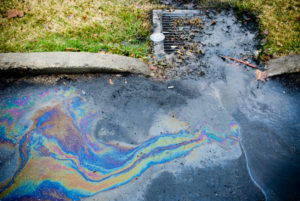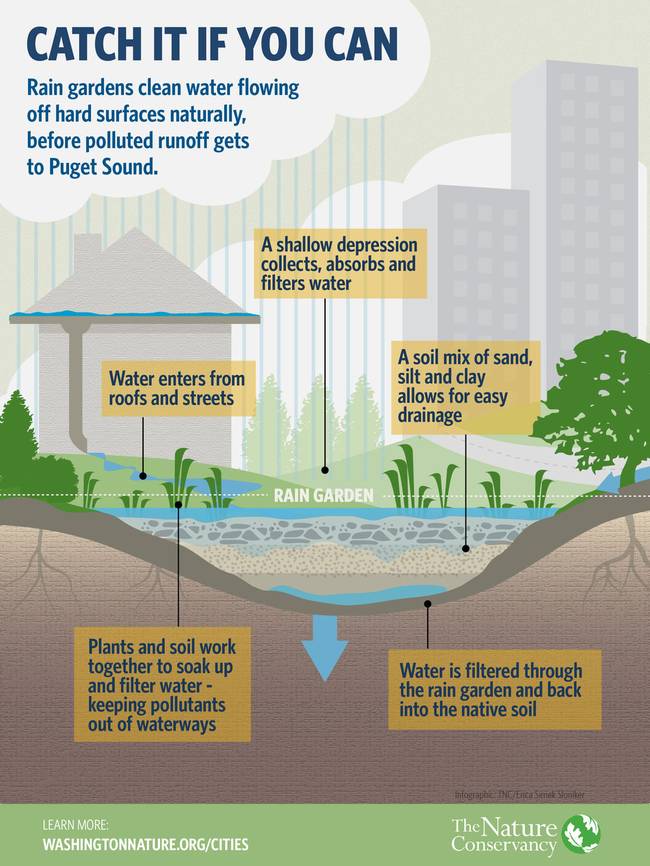
Oil runoff into a storm drain.
Every time it rains, water is always seen running down street gutters, into storm basins and eventually flowing back to the ocean. Carrying away pollution and nutrients from our landscapes.
Businesses and government organizations have been working to reduce urban run-off and it is time to homeowners to join the effort and help the cause. Why? Because it is the right thing to do.
Seriously. If we let water soak into the ground or save it in large containers at home, we lower our dependency on the water distribution system (for landscape irrigation) which in turn saves money and energy in the form of pumping costs to deliver water.
Lowering rainwater run-off also has other benefits as it can lower the chance of flooding in low lying areas during major rain events and reduces the volume of pollutants – such as pesticides and fertilizers – from flowing from our properties to streets and eventually ending up in local water ways. Plus, if we work to put rainwater into the ground, we can raise the water table which helps replenish groundwater levels around the state.
Los Angeles County Public Works
For the last 2 big rain events in southern California, the LA Co Public Works has captured 439 Million gallons of rainwater, enough for 10,760 people for a year.
253 million gallons of #LArain captured over the weekend. That’s enough to supply 6,200 people for one year. #LAweather #CAwx pic.twitter.com/KokvMksGFt
— LA Co Public Works (@LACoPublicWorks) November 21, 2016
186 million gallons of #LARain were captured over the weekend. That’s enough water to serve 4,560 people for one year. #CAwx #LAweather pic.twitter.com/qc6JmHlnbW
— LA Co Public Works (@LACoPublicWorks) November 28, 2016
Which means the average person will use 40,799 gallons of water per year which about 60% of it goes to landscape irrigation, which accounts for about 24,500 gallons. If we work to save this water in the ground, we could easily reduce water consumption by 5-10%.
The Nature Conservancy
In Seattle’s Puget Sound, “rainwater runoff is a HUGE polluter” wrote Chris Hilton, Urban Partnership Director for The Nature Conservancy in Washington state. “In fact, runoff is the single-largest source of pollution for Puget Sound. Some 14 Million pounds of pollutants are washed into the Sound every year.” A study was performed to compare “the health of coho salmon in untreated runoff water with same in runoff water treated with nature-based solutions – like rain gardens. Salmon died in the untreated water and thrived in the treated water.” No surprise there.
If this is going on in Puget Sound, where it rains all the time, imagine what is going on in your local community?
Scotts Valley Water District
Scotts Valley Water District is highly dependent on groundwater to provide drinking water to their community. This project will improve water quality and increase infiltration capacity through low impact development (LID) and landscape improvement features. This is why they are spending $1.5 million to build this project underground the Scotts Valley Transit Center and within existing landscaped areas.
The Scotts Valley Facebook page posted a series of pictures in September 2016. When asked what homeowners can do – “Permeable pavement and “smart” landscaping serves the same purpose. Although constructing a solution to achieve the penetration into the deeper aquifers is costly. Water District undertook this project because of the availability of State grant funding.”
So it all comes down to cost and what a homeowner is willing to do.
This is an example of what three agencies are doing to reduce urban runoff. We can’t depend on all public agencies to save water for us, at some point, we need to take action for ourselves and reduce runoff at home.




0 Comments
1 Pingback